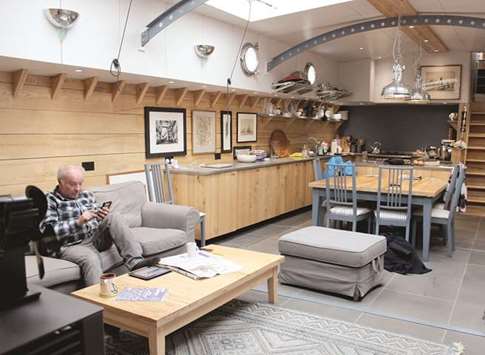A bath in front of the fire, a spacious kitchen-living room and a double bed with a view of the starry skies – Charlie McLaren’s home has a lot of the things many people dream about.
But the 67-year-old doesn’t live in a house. He lives in an old container ship.
The 32-metre VIOD II rises and falls gently on the waters of the Thames at Hermitage Moorings, near London’s Tower Bridge, alongside 17 other historical boats which are also home to families, pensioners and professionals.
Houseboats have become a popular alternative to renting expensive flats and houses in the British capital. But at Hermitage, there’s a greater attraction than just a better deal on rent.
“It’s something quite special to know all your neighbours by name in the middle of London,” says McLaren, who first moved onto a boat 50 years ago and bought the VIOD II three years ago.
In the summer, sometimes all of the boats sail out to sea together, or the neighbours gather for a barbecue. They also run a charity which helps teach children about the Thames.
Nevertheless, the community isn’t the main pull of houseboat living for McLaren. “It gives me a feeling of freedom,” he says.
The former journalist and his partner pay around 900 pounds (1,200 dollars) a month for the privilege of living on a boat, a price which includes council tax, heating, hot water, maintenance work and mooring.
To live in the same area of central London in a room with an integrated kitchen and a small bathroom will set you back about 1,500 pounds a month, according to estate agent Foxtons.
“For most people, high property prices play a significant role in their decision to live on a houseboat,” says Fran Read of the Canal & River Trust, which manages most of London’s waterways, though not the Thames.
“Between 2012 and 2016, the number of boat owners [in London] shot up by 57 per cent,” she adds. Almost 60 per cent of the 3,600 boats in the capital are used as residences.
But for most houseboat dwellers, who unlike McLaren don’t have a permanent mooring, the law states that they have to change location every two weeks.
“The competition for moorings in London is huge,” says Read. “Sometimes I think of it like a game of Tetris.”
The National Bargee Travellers Association campaigns for the interests of itinerant boat dwellers and tries to help them with the difficulties that the lifestyle entails.
It was founded in 2009 and now has around 750 members.
Spokesman Nick Brown, who himself lives on a boat, says he helped 70 people last year who had problems with the authorities or difficulty finding moorings with the necessary infrastructure, such as clean water and waste disposal facilities.
Most of their boats are nowhere near as luxurious as that of McLaren – they are often narrow and have tiny kitchens and bathrooms. Underfloor heating like that on the VIOD II is unheard of.
But all houseboat dwellers have to deal with the same everyday chores, whether they have a permanent mooring or not.
“Life on a boat comes with its own specific challenges,” says Read. “For example, you have to fill the water tanks, empty the toilets and often do a lot of maintenance work. It can be so time-consuming it’s like having a part-time job. You should think very carefully if you’re ready for that.”
McLaren has never regretted his decision and intends to live on his boat for as long as his health will allow him.
And he’s already thought about the future. “Everything that’s possible in a house is possible on a boat,” he says. “When it becomes more difficult to walk, I can build myself a stairlift.” - DPA

Charlie McLaren lives in an old container ship on the waters of the Thames. Houseboats have become a popular alternative to renting expensive flats in the British capital, London.
